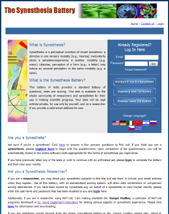
Synesthesia is a perceptual condition in which information between the senses is blended. Our laboratory is working to understand synesthesia from three angles. First, we have collected and rigorously verified over 20,000 synesthetes (Novich, Cheng, Eagleman, 2011). Second, we are performing high-throughput neuroimaging to understand the small differences in brain circuitry that cause synesthesia (Tomson et al, 2012, in preparation). Finally, we are performing a family linkage analysis to pull the gene for synethesia (Tomson et al, 2011).
To speed and standardize the study of synesthesia, we have developed a standardized battery for testing and quantifying the phenomenon at synesthete.org. This battery of questionnaires and online software is free and open to the public, and provides a rigorous, standardized scoring system. Do you think you might be a synesthete? Go to synesthete.org to find out. Are you a researcher? Have your test subjects enter your email in the ‘Share results with a researcher?’ field, and you will be automatically emailed a link to view their results.
For an overview and framework of the field, please see my book on synesthesia: Wednesday is Indigo Blue: Discovering the Brain of Synesthesia (MIT Press, co-authored with Richard Cytowic).
Here’s what Oliver Sacks wrote about the book:
“Twenty years ago, synesthesia – the automatic conjoining of two or more senses – was regarded by scientists (if at all) as a rare curiosity. We now know that perhaps one person in twenty is synesthetic, and so we must regard it as an essential, and fascinating, part of the human experience. Indeed, it may well be the basis and inspiration for much of human imagination and metaphor. No one has done more than Richard Cytowic and David Eagleman to bring a careful neuroscientific attention to synesthesia, grounded in decades of research and reports from thousands of patients. Their work has changed the way we think of the human brain, and Wednesday Is Indigo Blue is a unique and indispensable guide for anyone interested in how we perceive the world.”
For a quick description of synesthesia, watch lab grad student Steffie Tomson explain–as seen on Nova ScienceNOW
For some of our papers on synesthesia, see:
- Schwettmann SE, Kadipasaoglu CM, Ma WJ, Eagleman DM. Implicit mapping of musical relationships onto color space in chord-color synesthesia. [In Press]
- Watson MR, Chromy J, Crawford L, Eagleman DM, Enns JT, Akins KA (2016). The prevalence of synaesthesia depends on early language learning. Consciousness and Cognition. 48:212-231 [Full text]
- Witthoft N, Winawer J, Eagleman DM (2015). Prevalence of learned grapheme-color pairings in a large online sample of synesthetes. PLoS ONE. 10(3): e0118996. [Full text]
- Bosley H, Eagleman DM (2015). Synesthesia in twins: Incomplete concordance in monozygotes suggests extragenic factors. Behavioural Brain Research. [Full text]
- Carmichael DA, Down MP, Shillcock RC, Eagleman DM, Simner J (2015). Validating a standardised test battery for synesthesia: Does the Synesthesia Battery reliably detect synesthesia?, Consciousness and Cognition, 33: 375-385. [Full text]
- Hung WY, Simner J, Shillcock R, Eagleman DM (2014). Synaesthesia in Chinese characters: The role of radical function and position. Consciousness and Cognition. 24C:38-48. [Full text]
- Tomson SN, Narayan M, Allen GI, Eagleman DM (2013). Neural networks of colored sequence synesthesia. Journal of Neuroscience. 33(35):14098-106. [Full Text]
- Zamm A, Eagleman DM, Schlaug G, Loui P (2013). Pathways to Seeing Music: Enhanced Structural Connectivity in Colored-Music Synesthesia. NeuroImage. [Full text].
- Eagleman DM (2012). Synesthesia in its protean guises. British Journal of Psychology. 103(1):16-19. [Full text]
- Novich SD, Cheng S, Eagleman DM (2011). Is synesthesia one condition or many? A large-scale analysis reveals subgroups. Journal of Neuropsychology. 5:353-371. [Full text]
- Tomson SN, Avidan N, Lee K, Sarma AK, Tushe R, Milewicz DM, Bray M, Leal SM, Eagleman DM (2011). The genetics of colored sequence synesthesia: Suggestive evidence of linkage to 16q and genetic heterogeneity for the condition. Behavioural Brain Research. 223(2011):48-52. [Full text]
- Eagleman DM (2010). Synaesthesia. British Medical Journal. 340: b4616 [Full text]
- Eagleman DM (2009). The objectification of overlearned sequences: A large-scale analysis of spatial sequence synesthesia. Cortex. 45(10): 1266-1277. [Full text]
- Eagleman DM & Goodale MA (2009). Why color synesthesia involves more than color. Trends in Cognitive Sciences. 13(7): 288-292. [Full text]
- Eagleman DM, Kagan AD, Nelson SN, Sagaram D, Sarma AK (2007). A standardized test battery for the study of Synesthesia. Journal of Neuroscience Methods. 159: 139-145. [Full text]
In 2006, my laboratory hosted the American Synesthesia Association annual meeting in Houston. In 2010, I was the keynote speaker for the UK Synaesthesia Association annual meeting.
"David Eagleman offers startling lessons.... His method is to ask us to cast off our lazy commonplace assumptions.
- The Guardian
"A popularizer of impressive gusto...[Eagleman] aims, grandly, to do for the study of the mind what Copernicus did for the study of the stars."
- New York Observer
"[A] neuroscientist and polymath."
- Wall Street Journal
"David Eagleman may be the best combination of scientist and fiction-writer alive."
- Stewart Brand
"David Eagleman is the kind of guy who really does make being a neuroscientist look like fun."
- New York Times
"Eagleman has a talent for testing the untestable, for taking seemingly sophomoric notions and using them to nail down the slippery stuff of consciousness."
- The New Yorker
"What Eagleman seems to be calling for is a new Enlightenment."
- Sunday Herald








